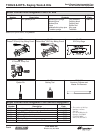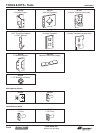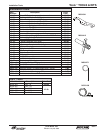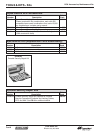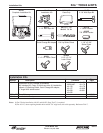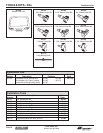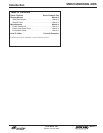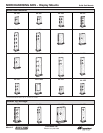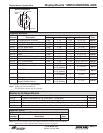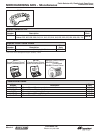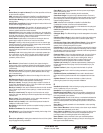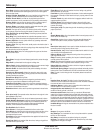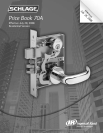
Glossary
Price Book 70A
Effective July 28, 2008
Gloss-4
Sash Cord:
Cord or rope used similarly to sash chain and in place of
chain.
Sash Cord Iron:
A small metal holder inserted in the edge of the sash,
to which sash cord or sash chain is attached.
Sash Fast:
A fastener attached to the meeting rail of double-hung
windows.
Sash Lock:
A sash fast with a locking de vice controlled by a key
Sash Pole:
A wood or metal pole to which a sash pole hook is attached.
Sash Pole Hook:
A metal hook attached to a wooden or metal pole
used to lower or raise a transom or sash beyond hand reach.
Sash Pulley:
A pulley mortised into the frame of a double-hung sash
frame over which the sash cord or sash chain passes.
Sash Socket:
A metal plate containing a hole or cup to receive a sash
pole hook
Sash Weight:
A weight used to balance sliding sash, usually of cast iron
or, if conditions require, of lead.
Screen Door Latch:
A small locking or latching device used on screen
doors and operated by a knob or a lever handle.
Screwless Knob:
A knob attached to a spindle by means of a special
wrench as distinguished from the more commonly used side knob screw.
Screwless Rose:
A rose with concealed method of attachment.
Secret Gate Latch:
A surface-applied latch operated by a concealed
button or other device; usually used on office gates.
Shank (of a knob):
The projecting stem of a knob into which the spindle
is fastened.
Shelf Pin:
A pin for supporting a shelf; also called a shelf support or shelf
rest.
Shutter Operator (also called a Shutter Worker):
A device
incorporating a hinge and a method of opening or closing a shutter by
means of a crank or turn from inside without opening window.
Side Knob Screw:
A set screw used to fasten a knob to a spindle.
Signal Sash Fastener:
A sash fastening device to lock double-hung
windows that are beyond reach from the floor It has a ring for a sash pole
hook. When locked, the ring lever is down; when the ring lever is up, it
signals by its upright position that the window is unlocked.
Spindle (of a knob):
The bar or tube connected with the knob or lever
handle that passes through the hub of the lock or other wise engages the
mechanism to transmit the knob action to the bolt(s).
Split Astragal:
An astragal that is split through the middle, allowing each
door leaf to operate independently
Spring Hinge:
A hinge containing one or more springs to move the door
into the de sired position. It may be either single or double acting.
Stile (of a door):
A vertical member of the door structure; each door has
two, a lock stile and a hinge stile.
Stop (of a lock):
The button, or other small device, that serves to lock
the latch bolt against the outside knob or thumb piece or unlock it if locked.
Another type holds the bolt retracted.
Store Door Handle:
A heavy grip or pull mounted on sectional or
elongated plates and provided with a thumb piece to operate the latch trip
of a store door lock.
Strap Hinge:
A surface hinge of which one or both leaves are of
considerable length.
Strike:
A metal plate or box that is pierced or recessed to receive the bolt
or latch when projected. Sometimes called Keeper.
Surface Hinge:
One having both leaves surface applied.
Swinging Latch Bolt:
A bolt that is hinged to a lock front and is
retracted with a swinging rather than a sliding action. Sometimes called
Hinged Latch Bolt.
Swivel Spindle:
A spindle having a joint midway in its length to permit
the knob at one end to be made rigid by the stop works while the other end
is free to operate.
T
T Handle:
A cross handle for actuating the bolt of a lock and used in
place of a knob.
T Hinge:
A surface hinge with the short member attached to the jamb and
the long member attached to the door.
Template Hardware:
A term indicating any item of hardware that is
made to template; that is, exactly matching the master template drawing as
to spacing of all holes and dimensions.
Thimble:
The socket or bearing attached to an escutcheon plate in which
the end of the knob shank rotates.
Three-Point Lock:
A device sometimes required on three-hour fire
doors to lock the active leaf of a pair of doors at three points.
Threshold:
A strip fastened to the floor beneath a door, usually required
to cover the joint where two types of floor material meet.
Throw (of a deadbolt or latch bolt):
Measurement of the maximum
projection when bolt is fully extended.
Thumb Piece (of a handle):
The small pivoted part above the grip of
a handle to be pressed by the thumb to operate a latch bolt.
Transom Bar:
That part of a door frame that separates the top of a door
or a window from the bottom of the transom
Transom Catch:
A fastener applied to a transom and having a ring by
which the latch bolt is retracted.
Transom Chain:
A short chain used to limit the opening of a transom;
usually provided at each end with a plate for attachment.
Transom Lift:
A vertically operated device attached to a door frame and
transom by which the transom may be opened or closed.
Tubular Lock (or Latch):
A type of bored lock
Tumbler:
A guard or obstruction that pre vents operation of a bolt except
by insertion of the proper key
Turn Piece:
A small knob, lever or tee turn with spindle attached for
operating the deadbolt of a lock or a mortise bolt.
Two-Point Latch:
A device sometimes required on three-hour fire doors
to lock the inactive leaf of a pair of doors at top and bottom.
U
Unit Lock:
See Preassembled Lock.
Universal:
A term used to describe a lock, a door closer or other device
that can be used on doors of any hand without change.
V
Vertical Spring Pivot Hinge:
A spring hinge mortised into the heel of
a door and fastened to the floor and head with pivots.
W
Ward:
An obstruction projecting from the lock case of side of a keyhole
intended to prevent entrance or rotation of an improperly cut key.



